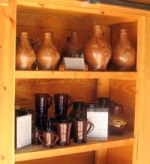-
History of:
- Resources about:
- More:
- Baby walkers
- Bakehouses
- Bed warmers
- Beer, ale mullers
- Besoms, broom-making
- Box, cabinet, and press beds
- Butter crocks, coolers
- Candle snuffers, tallow
- Clothes horses, airers
- Cooking on a peat fire
- Drying grounds
- Enamel cookware
- Fireplaces
- Irons for frills & ruffles
- Knitting sheaths, belts
- Laundry starch
- Log cabin beds
- Lye and chamber-lye
- Mangles
- Marseilles quilts
- Medieval beds
- Rag rugs
- Rushlights, dips & nips
- Straw mattresses
- Sugar cutters - nips & tongs
- Tablecloths
- Tinderboxes
- Washing bats and beetles
- Washing dollies
- List of all articles
Subscribe to RSS feed or get email updates.
Crockery - Brown earthen pans are said to be best for milk and for cooking. Tin pans are lighter, and more convenient, but are too cold for many purposes. Tall earthen jars, with covers, are good to hold butter, salt, lard, etc. Acids should never be put into the red earthen ware, as there is a poisonous ingredient in the glazing which the acid takes off. Stone ware is better and stronger, and safer every way than any other kind.
Catharine E. Beecher and Harriet Beecher Stowe, The American Woman's Home, 1869
American redware - rare beauty in red clay?
 When the first European settlers arrived
on the other side of the Atlantic they soon started using the plentiful red clay
to make unpretentious earthenware pots, pans and plates, much the same as those
they had used at home. In the 18th and 19th centuries there were skilled potters
all over the USA producing a range of useful, well-made domestic pieces.
When the first European settlers arrived
on the other side of the Atlantic they soon started using the plentiful red clay
to make unpretentious earthenware pots, pans and plates, much the same as those
they had used at home. In the 18th and 19th centuries there were skilled potters
all over the USA producing a range of useful, well-made domestic pieces.
Many were sealed with lead glazes, beautiful but toxic. Though the dangers of using these crocks for food were known, there were few alternatives until the mid-19th century. By then some housekeeping manuals recommended stoneware alternatives, since "acids should never be put into the red earthen ware, as there is a poisonous ingredient in the glazing which the acid takes off." (See left-hand column) But not all writers were so careful. Mrs. Mason gave recipes for baked apples and tomato marmalade which used "earthen" containers.
 All this red earthenware is now described as American redware by the antiques market,
and the most attractive pieces are selling for
5-figure prices. Jugs or jars with pleasing curves are treasured as part
of a national or regional heritage, however humble their original use in the kitchen,
where they were once called "earthen" and not "redware". Reproductions and new pieces
in the traditional style are desirable gifts and souvenirs. (See giftshop left)
All this red earthenware is now described as American redware by the antiques market,
and the most attractive pieces are selling for
5-figure prices. Jugs or jars with pleasing curves are treasured as part
of a national or regional heritage, however humble their original use in the kitchen,
where they were once called "earthen" and not "redware". Reproductions and new pieces
in the traditional style are desirable gifts and souvenirs. (See giftshop left)
Does their value depend on supply and demand? One commentator has said he has "mixed feelings" about the current high esteem for redware pieces and wonders if this is an "artificial, hyped-up market". Writing in the Tribune of India he pointed out that American "utilitarian objects" made of "the most commonly found reddish clay all over the world" can hardly be distinguished from European-made items, and old pots are not much different from new.
In not much more than a century ordinary pots and pans have earned adjectives like rare and exceptional. However plain and simple they are, everyday objects from the past speak of their time and place in history. A scarce undamaged jar attributed to a named potter or family home evokes quite different feelings from a similar pot made far away. And feelings influence value.
...never buy low priced earthen ware, particularly that which looks like the substance of a common brick, when broken. The solid stone ware costs perhaps a quarter more, and is worth ten times a much as the other...
Solon Robinson, Home Comforts, or, Economy Illustrated by Familiar Scenes of Every Day Life, 1855
 4 June 2007
4 June 2007
You may like our new sister site Home Things Past where you'll find articles about antiques, vintage kitchen stuff, crafts, and other things to do with home life in the past. There's space for comments and discussion too. Please do take a look and add your thoughts. (Comments don't appear instantly.)
For sources please refer to the books page, and/or the excerpts quoted on the pages of this website, and note that many links lead to museum sites. Feel free to ask if you're looking for a specific reference - feedback is always welcome anyway. Unfortunately, it's not possible to help you with queries about prices or valuation.


